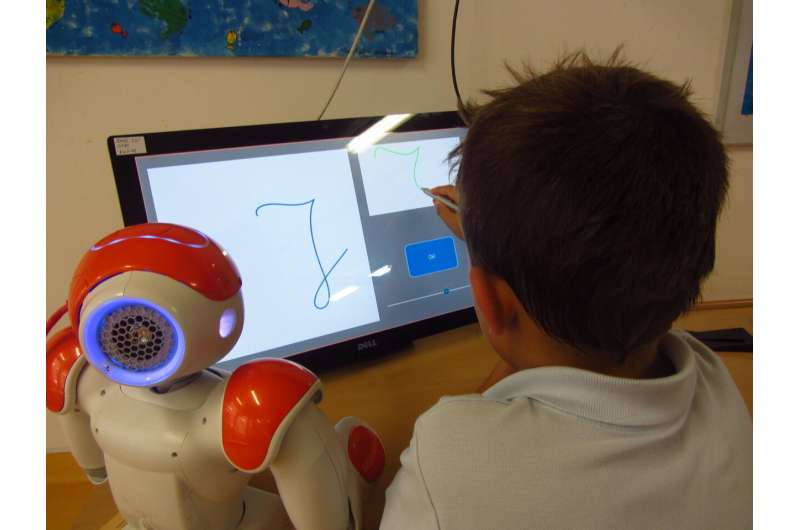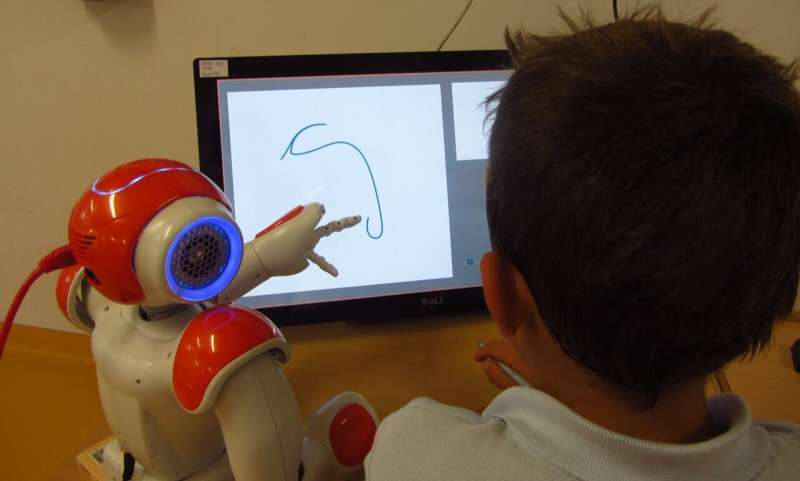October 4, 2019 feature
A social robot to enhance children's handwriting skills

Researchers at CHILI Lab (Ecole Polytechnique Fédérale de Lausanne) in Switzerland and GAIPS Lab (University of Lisbon) in Portugal have recently developed an autonomous system designed to assist children in improving their handwriting skills. The system they created, presented in a paper published in Springer's International Journal of Social Robotics, entails the use of a social robot in one-to-one learning sessions with children.
For some children, handwriting can be a difficult skill to acquire, yet it is a fundamental stepping stone in their academic path. In fact, poor handwriting can negatively affect a child's academic performance, self-esteem and learning motivation.
To master handwriting, a child needs to learn to coordinate cognitive, motor and perceptual abilities, thus he/she might also require a considerable amount of practice. This is why children who find writing by hand particularly challenging are generally offered extra support by their teachers during one-to-one sessions.
"As the acquisition of handwriting skills is a physical task and often requires physical assistance and interaction, contemporary technologies such as social robots can be used as a tool to supplement existing handwriting intervention methods for children," Shruti Chandra, one of the researchers who carried out the recent study, told TechXplore. "With this vision in mind, our research aims at exploring how a social robot can autonomously help children with the acquisition of handwriting with an approach where the children are the teachers who help the robot to improve its handwriting."
The recent study carried out by the researchers at the GAIPS Lab is part of a broader project called CoWriter. The core objective of the CoWriter project is to build a robotic partner that children can teach handwriting to.
The general idea behind this is that teaching a robot how to write by hand can help children to improve their own ability to write; a paradigm known as learning-by-teaching. Past studies suggest that learning-by-teaching practices can be very effective in education, as they allow children to reflect on their own errors and improve, ultimately enhancing their academic skills, motivation and self-esteem.
"We developed an autonomous educational system incorporating a social humanoid robot (Nao by SoftRobotics) that provides a scenario for children to improve their handwriting skills, Chandra explained. "The current system relies on the learning-by-teaching paradigm with the goal of answering a question: How would the learning capabilities of a tutee impact the learning of a tutor?"
Chandra and her colleagues designed a one-to-one scenario that involves an interaction between a child and a social robot, in which the child takes on the role of a teacher or tutor, assessing the robot's handwriting skills. This learning scenario is designed to improve children's handwriting skills by asking them to tutor someone else. The learning system proposed by the researchers is fully autonomous, so it does not require any additional work or supervision during the child-robot interaction.
"The interaction begins when the robot asks for help from the child in correcting shapes of a few letters," Chandra said. "First, the robot writes a deformed letter on the screen and asks the child to correct it using the computer screen. The child performs correction by changing the shape of the letter through a slider and also provides demonstrations of the letter on the screen."
During the child-robot tutoring session, the robot makes some of the most common handwriting mistakes observed in 4-8 year old children, associated with proportion, breaks and alignment. This allows the child who is tutoring the robot to reflect on some of his/her own mistakes while correcting errors made by the robot.
To evaluate the effectiveness of the teaching system they developed, Chandra and her colleagues carried out two longitudinal studies in Portuguese primary schools, each involving four robot-child one-to-one tutoring sessions. They evaluated each participating child's handwriting skills and his/her perception of the social robot both before and after each session.

The children were assigned to one of three learning conditions: continuous learning, non-learning or personalized learning. This allowed the researchers to effectively compare the effects of each of these learning conditions on the children's learning and perceptions of the robot.
"In the continuous-learning condition, the robot learns continuously, within and between the sessions," Chandra said. "However, in the non-learning condition, the robot does not learn and continuously shows poor performance. Finally, in the personalized learning condition, the robot adopts the child's performance throughout the sessions, meaning if a child performs well, the robot would perform better or vice-versa."
Before the beginning of each tutoring session, the children were asked to complete a pretest evaluating their handwriting skills. Subsequently, they performed the collaborative writing activity, in which each child was asked to teach the robot how to write by hand. Finally, at the end of the task, the researchers asked the children questions regarding their perceptions about the interaction with the robot.
"Following the four sessions with the robot (once every week), the participants performed a post-test identical to the pretest to evaluate the effect of the four sessions on participant's handwriting skills," Chandra said. "We then compared the children's pre- and post-test scores to evaluate their learning gains within and between the conditions. Similarly, the children's perceptions were analyzed and compared between and within the conditions."
The researchers analyzed the data they collected and found that the handwriting skills of children in the personalized learning and continuous-learning conditions improved substantially after the tutoring sessions. On the other hand, the handwriting of children in the non-learning condition did not improve significantly. In other words, tutoring a robot with some handwriting competency appeared to help the children improve their own skills, far more than tutoring a robot with no competency.
"We also found that the children's perceptions regarding some of the robot's learning capabilities, such as writing ability and overall performance, changed over time," Chandra said. "After the last interaction, more than 92% of the children in the first study and all the children in the second study not only rated themselves as a good teacher but also liked tutoring the robot and wanted to teach it in the future."
In addition to enhancing the children's handwriting skills, the learning approach devised by the researchers also appeared to strengthen the children's confidence in their abilities. Interestingly, the robot's competency did not affect how confident in their abilities the children felt after the exercise, as they typically considered themselves as competent teachers regardless of whether the robot had improved or not.
"In general, we found that the children well accepted the system in both studies for a few reasons," Chandra said. "Firstly, we were able to conduct two multi-session studies successfully in two different schools in Lisbon, Portugal and the children engaged with the robot throughout four to six weeks. Secondly, we found that most of the children wanted to teach the robot in the future."
In the future, the autonomous educational system developed by Chandra and her colleagues could be used to teach children handwriting skills in an engaging and innovative way. Moreover, the results of initial evaluations in schools suggest that it could help to increase both children's handwriting and their confidence in their skills.
The researchers are now conducting another study for the CoWriter project that investigates the use of a similar system to teach children with severe handwriting impairments. In this case, the children will be taking part in sessions with a therapist and the Nao social robot.
"In these other studies, a therapist is present to facilitate the child regarding the task-related queries and interaction with the social robot, over several months in hospitals located in Lausanne, Switzerland, and Paris, France," Chandra said. "We are planning to keep doing such studies with robots as these children need several sessions for improvement. Our group at the CHILI Lab has also recently developed an app called Tegami for making granular dysgraphia diagnoses in children so that they can receive personalized treatment for learning how to write."
More information: Shruti Chandra et al. Children Teach Handwriting to a Social Robot with Different Learning Competencies, International Journal of Social Robotics (2019). DOI: 10.1007/s12369-019-00589-w
Deanna Hood et al. The CoWriter Project, Proceedings of the Tenth Annual ACM/IEEE International Conference on Human-Robot Interaction Extended Abstracts - HRI'15 Extended Abstracts (2015). DOI: 10.1145/2701973.2702091
Nao by SoftBank Robotics: www.softbankrobotics.com/emea/index.php/en/nao
Computer-Human Interaction In Learning And Instruction Chili: chili.epfl.ch/
GAIPS - Intelligent Agents and Synthetic Characters Group: gaips.inesc-id.pt/
© 2019 Science X Network


















